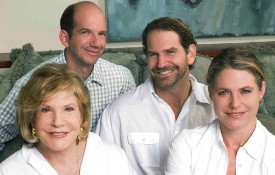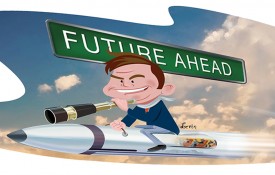Howard Hughes, Jr. moved to Los Angeles from Texas in 1925 to leverage his diverse talents and knack for invention. That he did and more. By September 1945, the end of WWII, Hughes Aircraft Company employed 80,000 workers designing and building planes, making Hughes the largest employer in the region. By the 1960s his products—spacecraft, radar systems, the first working laser, and commercial satellites—were changing the world. Today his legacy of innovation lives on in Playa Vista, where his former headquarters stands at the center of LA’s most bustling business center, where one can find media companies, ad agencies, university-affiliated institutes and start-ups working alongside the world’s most-established tech giants.
LA’s economic hubs, like Playa Vista, were not created overnight. They were born from the imaginations of a long list of business leaders, developers, and planners who took advantage of the city’s climate, growing population, and expanding road network to grow LA outward from its center in downtown. For most of the nineteenth century, Hughes and investors like him benefited from abundant tracts of vacant land that allowed them to develop the infrastructure needed to fulfill the nation’s demand for planes, automobiles, movies, and space and weapons programs.
World War II accelerated LA’s economic development in two important ways. First, public works projects, including the expansion of the airport and Port of LA, increased rapidly to keep up with the flow of goods and people around the LA basin. Second, with its newly forming dense master-planned centers that situated planned urban developments within close proximity to industrial development, LA started to become polycentric. Richard Neutra’s Channel Heights project in San Pedro became the nation’s prototype with its well-designed homes, schools, day-care facilities, playgrounds, and shopping center. This development was needed to house some of the 90,000 workers producing thousands of wartime vessels in San Pedro’s shipyards.

Howard Hughes, holding a pilot’s helmet, is seen standing beside the H-1 Racer circa 1935-1937
Photo courtesy of UNLV Special Collections
By the 1990s, globalization brought economic development and job creating opportunities to regions of the world willing to offer better tax and regulatory climates than California. Over time LA’s multiple economic centers began to shrink, the impact of which can be seen today throughout LA’s communities. The City of LA has 15 council districts, and each one equally represents 250,000 residents. What is not equally represented is the amount of good jobs per district – District 14 (downtown/northeast LA) has 333,000 jobs while District 8 (south LA) has 18,890. The median income in District 12 (San Fernando Valley) is $77,000 and only $26,152 in District 1 (northeast and northwest LA).
Revitalizing LA will not happen through outward expansion. LA must reclaim underutilized space to foster economic and job growth. A 2014 report commissioned by the City of LA shows that the City owns more than $3B worth of real estate, and significant properties are currently being underutilized. New York City’s legendary planner Robert Moses, who mastered the planning game and setting the right conditions for economic growth, always saw the value of investing in “the public realm,” and Angelenos should, too.
Following are three districts in the region that are doing just that.
Century Boulevard District is known as the “Gateway to LA” because it’s the first impression millions of travelers from Los Angeles International Airport (LAX) experience of LA. Driving east from LAX, visitors will see an urban landscape that lacks economic vitality. Driving north into Playa Vista and south into El Segundo gives the opposite impression. This is about to change. The Airport Commission, with the backing of the business and labor communities, recently approved plans that will invest $4B into LAX’s ground transportation system. This will include an automated train that will connect passengers to the terminals, a new passenger meet-and-greet facility, a rental car center, and LA Metro’s planned Crenshaw Line station at 96th Street/Aviation Blvd. These projects will begin to free up hundreds of acres of airport-owned land for public/private development (retail and commercial) and incentivize the local business district to transform Century Boulevard into a pedestrian-friendly urban landscape that will also include improved bicycle connectivity to transit options. Plenty of vacant and low-cost commercial space is now available for biotech, finance, technology, and media companies looking for a location that puts them in close proximity to major freeways, future public transit, the beach, and affordable neighborhoods. LA City’s recent passage of a reduction of the business tax could be one more incentive to help this along.
San Pedro is the City of LA’s waterfront and home to the region’s largest job generators – the Ports of LA and Long Beach. Increased global competition, labor disputes, and a shrinking job base have forced San Pedro to look beyond its reliance on the goods movement and consider other economic opportunities around tourism, technology, and science. The Port of LA’s ongoing $1.2B master plan incorporated 400 acres of its most underutilized land along the waterfront to stimulate San Pedro’s economic revitalization. Plans are underway to create parks, public squares, bike paths, and pedestrian-oriented streets to incentivize private investors to develop Ports O’ Call (retail and dining), Cabrillo Marina (retail), and high-density housing, retail, commercial, and school facilities at Rancho San Pedro – WWII-era public housing situated on 21.2 acres. What San Pedro needs is an economic driver that creates a seven-day-a-week economy, and AltaSea’s efforts to transform a 100-year-old pier at the Port of LA into the world’s only “ocean-based ideas and innovation center” could do just that. Within a decade the world’s leaders in marine research, biomedical and aqua-farming could be housed in San Pedro helping to transfer research into private business opportunities. Port Tech LA has already helped established San Pedro as a place where entrepreneurs, innovators, and investors can come together to advance clean technologies, and many more opportunities exist for business investors looking to provide solutions for the Port’s operations, logistics, and security. These investments will connect people, ideas, and resources in a region that also happens to have affordable housing.
Downtown LA is now a valued residential community offering cultural events, dining, retail, entertainment, and sporting events. It is also the second largest office market in the region, but only home to two percent of the region’s workforce. Fifteen years ago the City Council passed an adaptive reuse ordinance to create more housing and City (and County) leaders should build on that success by leveraging its underutilized real estate, such as the LA City Mall, Parker Center, and Lincoln Heights Jail, to foster the development of a more robust business community. There are presently early elements of a tech ecosystem – The Reef (formerly LA Mart), Hub LA, Cross Campus, a few select colleges, WeWork, and the Mindshare – that could expand with the development of more low-cost office and industrial space. And the City and County could also employ this strategy to accelerate the development of a biotech ecosystem that will begin to take shape when the University of Southern California advances the development of a biotechnology park adjacent to its Health Science campus. Judging by the number of cranes in the sky, we can see that downtown’s economic revitalization is fully underway, and with the right alignment between government, academia, and industry, the creation of well-paying jobs will follow.
LA is no longer Dorothy Parker’s “72 suburbs in search of a city.” It is a landscape of diverse and unique communities that, with the right public/private investments, will attract a new generation of investors and entrepreneurs looking to turn their ideas into successful businesses that sustain LA’s economic vitality. After all, while we all know that Howard Hughes’ passion for aviation and the silver screen are legendary, it was his visionary investments in real estate that carry his legacy into the 21st century.














































